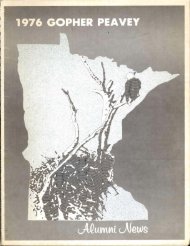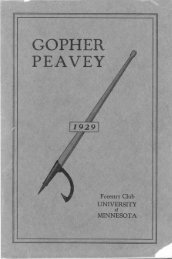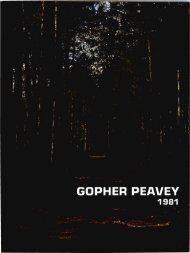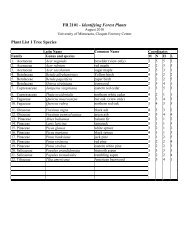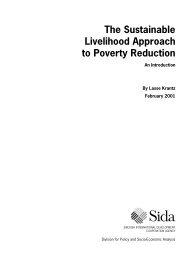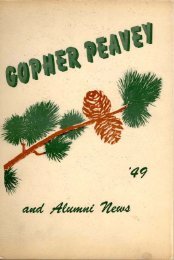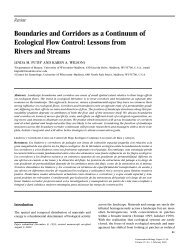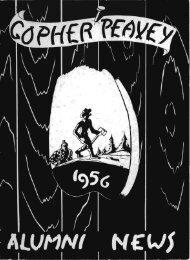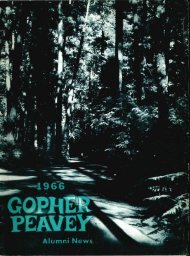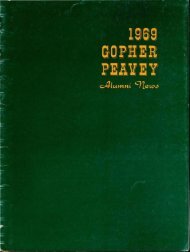The Nontimber Values of Tropical Forests - Department of Forest ...
The Nontimber Values of Tropical Forests - Department of Forest ...
The Nontimber Values of Tropical Forests - Department of Forest ...
Create successful ePaper yourself
Turn your PDF publications into a flip-book with our unique Google optimized e-Paper software.
THE NONTIMBER VALUES<br />
OF TROPICAL FORESTS<br />
by<br />
Norman Myers<br />
WORKING PAPER 10<br />
FORESTRY FOR SUSTAINABLE DEVELOPMENT PROGRAM<br />
<strong>Department</strong> <strong>of</strong> <strong>Forest</strong> Resources<br />
College <strong>of</strong> Natural Resources<br />
University <strong>of</strong> Minnesota<br />
1530 N. Cleveland Avenue<br />
St. Paul, Minnesota 55108<br />
November 1990
PREFACE ..............................................<br />
BACKGROUND .........................................<br />
--RESERVES ............................................. 1<br />
TRADrI'IONAL FOREST LAND AGROECOSYSIEM!j ...................... 4<br />
VALUEOFBIODIVERSITY ........................................... 7<br />
BUFFER ZONES AS A FORESTSAFEGUARD MEASURE ................. 10<br />
REFERENCES ...................................................... 12
PREFACE<br />
<strong>The</strong> author <strong>of</strong> this paper, Dr. Norman Myers, is an associate in the <strong>Forest</strong>ry For Sustainable<br />
Development (FFSD) Program at the University <strong>of</strong> Minnesota. Preparation <strong>of</strong> this paper<br />
was supported in part by the United Nations Environment Program. It is the tenth in a<br />
series <strong>of</strong> working papers produced for the FFSD Program at the University <strong>of</strong> Minnesota<br />
that represent work in progress. <strong>The</strong> purpose <strong>of</strong> these working papers is to stimulate<br />
discussion among individuals working in the field <strong>of</strong> interest.<br />
<strong>The</strong> major objectives <strong>of</strong> the FFSD Program are to:<br />
1. I m l<br />
forest? for sustainable development - translate state-<strong>of</strong>-the-art scientific and<br />
technical information into practical and easily usable management guides and<br />
training materials that can be used effectively in planning and implementing<br />
development projects that will contribute to sustainable development; and<br />
2. C f<br />
- identify and develop effective institutional mechanisms,<br />
both at the policy and project levels, for introducing sustainability strategies into the<br />
development planning process at an early enough stage to influence project or<br />
program design.<br />
<strong>The</strong> focus <strong>of</strong> the Program is on social forestry and related strategies within a watershed<br />
management framework as an integrating mechanism for moving toward sustainability in<br />
land use and in natural resource-based development projects. It involves an interdisciplinary<br />
group <strong>of</strong> faculty from the University <strong>of</strong> Minnesota, and associates at the University <strong>of</strong><br />
Arizona, Yale University, Oxford University, the InterAmerican Development Bank, and<br />
other development groups. <strong>The</strong> FFSD Program is part <strong>of</strong> the University <strong>of</strong> Minnesota's<br />
Center for Natural Resource Policy and Management in the College <strong>of</strong> Natural Resources.<br />
<strong>The</strong> FFSD Program is supported by a grant from <strong>The</strong> Pew Charitable Trusts, by the<br />
University <strong>of</strong> Minnesota's College <strong>of</strong> Natural Resources and <strong>Department</strong> <strong>of</strong> <strong>Forest</strong><br />
Resources, by the Minnesota Agricultural Experiment Station under Project 42-49 <strong>of</strong> the<br />
McIntire-Stennis Cooperative <strong>Forest</strong>ry Research Program, and by contributions from other<br />
organizations. Published as contribution No. 18,521 <strong>of</strong> the Minnesota Agricultural<br />
Experiment Station.<br />
For further information regarding the m;SD Program, contact:<br />
Dr. Allen L. Lundgren, Program Director (612) 624-1277, or<br />
Dr. Hans M. Gregersen, Pr<strong>of</strong>essor (612) 624-6298<br />
<strong>Department</strong> <strong>of</strong> <strong>Forest</strong> Resources<br />
115 Green Hall<br />
University <strong>of</strong> Minnesota<br />
1530 North Cleveland Avenue<br />
St. Paul, Minnesota 55108, U.SA. Fax: (612) 625-5212
FFSD Workha Pa~a #10 1<br />
THE NONTIME?ER VALUES OF TROPICAL FORESIS<br />
by<br />
Norman Myers1<br />
BACKGROUND<br />
<strong>Tropical</strong> forests are being misused and overused through forms <strong>of</strong> exploitation that focus<br />
on just a single output, e.g., hardwood timber or cattleland beef or agricultural opportunity-<br />
and these forms <strong>of</strong> exploitation entail gross disruption, if not destruction, <strong>of</strong> forest<br />
ecosystems with disregard for other outputs available such as nontimber products and<br />
environmental services. So a key question arises: is it possible to exploit the forests for<br />
products and services in ways that do not entrain depletion <strong>of</strong> forest resources, i.e., that can<br />
be harvested in sustainable (because self-renewing) fashion?<br />
This paper focuses on this key question, and seeks to answer it by looking at several<br />
categories <strong>of</strong> nontimber products and exploitation models, e.g., extractive reserves,<br />
traditional forest land agroecosystems and biodiversity. It also looks at a related<br />
management strategy to safeguard forests, vis the buffer zone: how far does this serve to<br />
supply a cordon sanitarie, especially if human use <strong>of</strong> the buffer zone features a mixture <strong>of</strong><br />
forestry and nonforestry activities?<br />
<strong>The</strong> rationale behind the paper is that we need to move beyond the unduly depletive modes<br />
<strong>of</strong> exploitation that now characterize almost all our use <strong>of</strong> tropical forests (Fearnside 1989a,<br />
Kohlhepp and Schrader 1987, Myers 1983, 1984, 1990, Robinson 1988). But this, in turn,<br />
raises a further key question: how far, both in principle and practice, can alternative<br />
exploitation modes, such as those addressed here, prove competitive with established modes<br />
(logging and the like)? Or, to be more concise, can they demonstrate that they supply a<br />
viable alternative in commercial and economic, also social and political, senses--and, if so,<br />
how far can we formulate broadscope models for widespread application? Or will they turn<br />
out to be so site-specific that it will be difficult to draw out any commonalities <strong>of</strong> approach<br />
for a development paradigm?<br />
EXXlZACIlVE RESERVES<br />
One <strong>of</strong> the most promising options for sustainable forest land exploitation lies with the<br />
concept <strong>of</strong> extractive reserves, pioneered by the late Chico Mendes, among others, in the<br />
Brazilian state <strong>of</strong> Acre (Anderson 1990, Fearnside 1989b, Hecht and Cockburn 1989,<br />
Instituto Brasileriro de Geografia e Estatistica 1984, Schwartzman and Allegretti 1987,<br />
1989). Broadly speaking, more than 13,000 people have been harvesting wild rubber and<br />
other products in some 27,500 sq km <strong>of</strong> Acre, supplying an annual income far above what<br />
could be derived through cattle ranching and small-scale agriculture. <strong>The</strong> reserves <strong>of</strong>fer<br />
more than 30 products with commercial value, plus noncommercial items such as food and<br />
medicines (Fearnside 1989b) consumed by the extractivists themselves. In the main, the<br />
extractivists comprise 68,000 rubber-tapper families (minimum figure) (Instituto Brasileriro<br />
de Geografia e Estatistica 1984), and these families are estimated to occupy between 4 and<br />
'~onsultant in Environment and Development, Oxford, England.
7 percent <strong>of</strong> Amazonia altogether, at a typical density <strong>of</strong> one family per 300-500 ha<br />
(Fearnside 1989b).<br />
As a measure <strong>of</strong> some economic values at issue, note that nonwood products extracted in<br />
Acre, Rondonia and Amazonas were worth an annual value <strong>of</strong> USS48 million as far back<br />
as 1980. Yet <strong>of</strong> Acre's 148,000 sq km <strong>of</strong> forests, well over 5,000 sq km have been destroyed<br />
and another 28,750 have been grossly degraded in the past few years. <strong>The</strong> "opportunity<br />
costs," i.e., the potential extractive-reserve revenues foregone, are already estimated to<br />
amount to hundreds <strong>of</strong> millions <strong>of</strong> dollars in this one state alone (Hecht and Cockburn<br />
1989).<br />
Notwithstanding the publicity that has been accorded to the extractive reserves <strong>of</strong> Acre, the<br />
same basic strategy is exemplified by experience in the northern Peten in Guatemala<br />
(Heinzman and Reining 1990). Comprising 35 percent <strong>of</strong> the country, the 36,000 sq km<br />
area is still almost 60 percent forested, even though tree cover is being rapidly depleted<br />
through incursions <strong>of</strong> settlers and squatters at a rate that surpasses 250 people per day on<br />
average, or almost 100,000 people per year. <strong>The</strong> most valuable <strong>of</strong> the extractive-reserve<br />
products is foliage collected from two specie. <strong>of</strong> palms, Chumtwbrea ebgans and C.<br />
oblongheu, both known locally as "xate." <strong>The</strong> foliage is sold on the international market<br />
where it is used as greenery in floral arrangements for weddings and funerals. Extending<br />
across a forest tract <strong>of</strong> some 14,000 sq km and with densities as high as 8,500 plants per ha,<br />
these understory palms grow to no more than 3 m in height, thus they are restricted to<br />
mature forests with their high shade and humidity. This means that extensive forest<br />
disturbance, let alone deforestation, serves to eliminate the resource (Heinzman and<br />
Reining 1990).<br />
Up to 7,000 forest-dwelling people are currently involved in extraction processes in the<br />
Peten, from harvesting and treatment to transportation and marketing <strong>of</strong> the plant materials.<br />
In 1987 some 140 million leaves were produced for export (primarily to the United States,<br />
but almost 60 million to Europe), with a foreign-exchange value to Guatemala <strong>of</strong> almost $2<br />
million, or 0.4 percent <strong>of</strong> all such exchange earning (Heinzman and Reining 1990).<br />
In addition, there are two other major extractive products known locally as chicle (ManiUram<br />
zupota) and allspice (Pimienta omin&). Several other nontimber products with significant<br />
value are available, e.g., ornamental and medicinal plants, latexes, fruits, nuts, and<br />
construction materials, all <strong>of</strong> which can be extracted sustainably (Heinzman and Reining<br />
1990).<br />
Note, moreover, that these extractive economies overlap in terms <strong>of</strong> people involved,<br />
transportation networks and forest camps. When demand for one product ebbs seasonally,<br />
other products can be harvested. Taken all together, they provide a broad resource base<br />
which actively exploits the inherent diversity <strong>of</strong> the forest tracts. <strong>The</strong>y give the forest high<br />
economic value, while <strong>of</strong>fering rural individuals a mode <strong>of</strong> deriving diverse incomes.<br />
<strong>The</strong> predominant current use <strong>of</strong> the Peten forests is milpa, small-scale subsistence farming<br />
based on forest clearing, cropping for two years, followed by six years <strong>of</strong> fallow. A<br />
preliminary analysis <strong>of</strong> the rnilpa system (Heinzman and Reining 1990), employing a 9<br />
percent discount rate for calculating present values, generates a net present value <strong>of</strong> $182
per ha, assuming constant yields over each succeeding cycle. If soil fertility diminishes from<br />
cycle to cycle as is usually the case, milpa generates a net present value <strong>of</strong> only $138 per ha.<br />
By contrast, xate extraction <strong>of</strong>fers a net present value <strong>of</strong> $380 per ha, assuming constant<br />
yields over time, and about $170 per ha if a mortality loss <strong>of</strong> 5 percent per year is assumed.<br />
In short, the strategy <strong>of</strong> a xate-based extractive reserve, as revealed by the net present value<br />
<strong>of</strong> cash income, appears to <strong>of</strong>fer an unusually beneficial economic use <strong>of</strong> forest lands, with<br />
income well above that to be derived from traditional slash-and-bum agriculture--which is<br />
not only economically inefficient but ecologically unsustainable.<br />
Given the demonstrated potential <strong>of</strong> extractive reserves, one might well ask, why is the<br />
strategy not more widely applied elsewhere? One answer to this perplexing question lies<br />
with the perception <strong>of</strong> the forestry "expert" as regards nontimber products. <strong>The</strong>y do not<br />
rank as "real" products like timber or beef that proclaim their (limited) value through a<br />
multitude <strong>of</strong> signals <strong>of</strong> the marketplace. Timber and beef are readily recognized and<br />
understood by government planners--unlike the bewildering multitude <strong>of</strong> nontimber products<br />
that present a "messy" challenge <strong>of</strong> tabulation, evaluation and marketing. To this extent, the<br />
problem lies not with the forests and their outputs, but with lack <strong>of</strong> understanding on the<br />
part <strong>of</strong> forestry planners. As an American news reporter (Carterton 1988) has put it, "Until<br />
the shades fall from the eyes <strong>of</strong> forestry experts, the forests themselves will continue to fall.<br />
Commercial timber, unfortunately, supplies a pretty solid beam to block the vision."<br />
All in all, and in the experience <strong>of</strong> this writer, extractive reserves present a viable alternative<br />
for tropical forest exploitation on a sustained-yield basis. <strong>The</strong> strategy is highly adaptable<br />
to a variety <strong>of</strong> local circumstances, depending not only on the forest products available but<br />
on the level <strong>of</strong> rural infrastructure (commercial outlets, marketing networks, credit facilities<br />
and the like), and on the degree <strong>of</strong> cash-economy involvement desired by communities in<br />
question.<br />
Equally significant, the extractive reserve concept lends itself to much elaboration and<br />
diversification in accord with the spectrum <strong>of</strong> products that could be further developed for<br />
self-renewing harvests. For illustration, consider the research model recently developed in<br />
western Amazonia (Peters et al. 1989). A single hectare <strong>of</strong> forest has been found to yield<br />
a sustainable annual harvest <strong>of</strong> wild fruits and latex with a net present value <strong>of</strong> around<br />
$6,330, using a discount rate <strong>of</strong> 5 percent. In contrast, a sustainable harvest <strong>of</strong> 30 m3 per<br />
ha <strong>of</strong> tree volume every 20 years, yields a net present value <strong>of</strong> $490 per ha (Peters et al.<br />
1989). But note that the two sets <strong>of</strong> outputs as documented are not strictly comparable:<br />
the first appears to refer to fmished products ready for a consumer market, while the second<br />
refers to the value <strong>of</strong> logs standing in the forest; and the analysis reveals various other<br />
economic shortcomings (Mendelsohn and Uhl 1990).<br />
Also in western Amazonia there is scope to exploit just a single resource, the oil-bearing<br />
vine (FevW spp.), on a sustainable basis, with revenues far exceeding what could be earned<br />
from logging (Gentry and Wettach 1986). <strong>The</strong> vines' seeds contain a higher content <strong>of</strong> oil<br />
than any other dicotyledonous plant known. If other vines and lianas in the forest were to<br />
be cut in order to increase the numbers and growth <strong>of</strong> the Fevillea vines, the per ha output<br />
<strong>of</strong> oil would compare to the most productive plantations <strong>of</strong> e.g., the African oil palm--but<br />
do it without cutting a single natural-forest tree, albeit with more than zero impact (not<br />
much <strong>of</strong> which needs to be significantly disruptive). Of course, this does not mean there
4 FFSD Workine Pamr #I0<br />
must be similar economically valuable plants in Caribbean forests. But given our extreme<br />
ignorance <strong>of</strong> the economic properties <strong>of</strong> the region's forest plants, it would be surprising if<br />
a number did not <strong>of</strong>fer significant economic and export potential--all unknown as that<br />
potential still remains.<br />
For a more broad-ranging extractive-reserve prospect, consider a preliminary investigation<br />
<strong>of</strong> potential within a forest tract <strong>of</strong> Amazonia in Ecuador. According to a preliminary and<br />
exploratory appraisal (Paucar and Gardner 1981), and drawing on the experience <strong>of</strong> local<br />
people who have long taken a self-sustaining harvest <strong>of</strong> wildlife products (partly in the form<br />
<strong>of</strong> meat for consumption, and partly in the form <strong>of</strong> skins and hides for export), wildlife<br />
proves to be a strongly renewable resource provided the level <strong>of</strong> exploitation is not<br />
excessive. As much as 85 percent <strong>of</strong> animal protein consumed by local people comes from<br />
wild animals, notably pacas, pecaries, deer, tapirs and agoutis, among more than 40 mammal<br />
species in all. A sustainable harvest <strong>of</strong> wild meat can amount to 240 kg per sq km, with a<br />
market value (late 1970s value) <strong>of</strong> about $1.8 per kg, or a total <strong>of</strong> almost $440 overall<br />
(Paucar and Gardner 1981). (Were the harvest to be systematized, and expanded to include<br />
buds, turtles and fish, the minimum potential value could be increased as much as ten<br />
times).<br />
Furthermore, since almost one-third <strong>of</strong> Ecuadorian Amazonia consists <strong>of</strong> swamps and rivers,<br />
there is plenty <strong>of</strong> scope for the harvest <strong>of</strong> caimans, at least two per ha per year. Thus, a<br />
square kilometer could yield an estimated 200 caimans per year. Since a caiman measuring<br />
1.5 m in length is worth roughly $145 for its hide at farm gate prices, a single square<br />
kilometer <strong>of</strong> such habitats could produce on a sustainable basis as much as $29,000 per year<br />
for the hides alone, not counting the value <strong>of</strong> the meat.<br />
In addition, each square kilometer <strong>of</strong> forest can renewably produce 20 primates each year<br />
for biomedical research. With an individual being worth between $200 and $300 at farm<br />
gate prices, a self-renewing harvest <strong>of</strong> wild primates could generate a minimum <strong>of</strong> $4,000<br />
per year. (For sure, many people object to the prospect <strong>of</strong> using wild primates to foster<br />
human health; and in the past, wild primate stocks have almost invariably been<br />
overexploited, sometimes critically so. But if this essential factor can be taken care <strong>of</strong>, there<br />
appears to be no additional objection to a sustainable harvest <strong>of</strong> wild primates, particularly<br />
ins<strong>of</strong>ar as the harvest should help to promote the survival <strong>of</strong> the primates' forest habitats.)<br />
This all means, using the values given above, that a forest tract <strong>of</strong> one square kilometer<br />
could, under scientific management; produce a sustainable crop <strong>of</strong> caiman and primates<br />
alone with a potential market value <strong>of</strong> perhaps $33,000 per year. This amounts to a market<br />
value <strong>of</strong> about $330 per ha per year, with a present gross value before costs <strong>of</strong> $6,000 per<br />
ha (using a 5% discount rate). In contrast, Peters et al. (1989) report an estimated present<br />
value <strong>of</strong> gross returns (discounted at 5%) from a typical Amazonian cattle pasture in<br />
Venezuela <strong>of</strong> $2,960 per ha, without allowing for costs <strong>of</strong> weeding, fencing, or animal care.<br />
TRADITIONAL FOREST LAND AGROECOSYSIEMS<br />
Certain forest-dwelling communities, <strong>of</strong>ten made up <strong>of</strong> tribal peoples, <strong>of</strong>fer myriad insights<br />
into ways to make sustainable use <strong>of</strong> forest plants and animals for food and other purposes.<br />
To illustrate, let's consider one <strong>of</strong> the most species-rich zones on earth, western Amazonia,
in order to examine the subsistence strategies developed by its forest inhabitants in order<br />
to make sustainable farming use <strong>of</strong> forest ecosystems. <strong>The</strong> case study serves as an<br />
illustrative example <strong>of</strong> agroecosystems elsewhere in tropical forests, where ethnobotanical<br />
knowledge promotes self-renewing exploitation <strong>of</strong> wild species. <strong>The</strong> more we can draw on<br />
the accumulated folkloric experiences <strong>of</strong> tribal peoples, the more we shall be able to<br />
formulate agrodevelopment models for replication in other parts <strong>of</strong> the tropical forest zone.<br />
In essence, the western Ammonia strategy depends on the exploitation <strong>of</strong> all forest<br />
resources that can be harvested in sustainable fashion (for some background documentation,<br />
see Posey et al. 1984). As such, the strategy incorporates three principal elements: 1)<br />
agriculture and aquaculture; 2) cropping <strong>of</strong> wild and semidomesticated species for food,<br />
notably plants but also mammals, fish, reptiles and the like; and 3) harvesting <strong>of</strong> a range <strong>of</strong><br />
other forest products for additional purposes, such as building materials and medicine.<br />
<strong>The</strong>se three activities are not practiced in isolation from each other. Rather they are<br />
pursued in concert, with mutually supportive benefit.<br />
Nor is the lifestyle confined to patches <strong>of</strong> cleared homesteads in forest environments.<br />
Rather it combines an intensive use <strong>of</strong> croplands with an extensive use <strong>of</strong> surrounding forest<br />
ecosystems. In other words, the strategy seeks to make self-sustaining use <strong>of</strong> such sectors<br />
<strong>of</strong> the forest as are cleared, while drawing widely on renewable resources <strong>of</strong> the forest<br />
environs.<br />
<strong>The</strong> strategy thus contrasts markedly with conventional agriculture in Ammonia, which leads<br />
to erosion and compaction <strong>of</strong> soils, to leaching <strong>of</strong> nutrients, to outbreaks <strong>of</strong> episodic pests<br />
and diseases, to rapidly declining crop yields and degradation <strong>of</strong> soils, and to clearing <strong>of</strong><br />
ever-greater tracts <strong>of</strong> forest. Hence, it also contrasts with those variations <strong>of</strong><br />
semimodemized agriculture that depend upon substantial inputs <strong>of</strong> synthetic fertilizers<br />
among other artificial additives. In short, it is a "native" agroecosystem, practiced with<br />
virtually no external inputs.<br />
<strong>The</strong> basis <strong>of</strong> the system is the growing <strong>of</strong> crops for food, in conjunction with trees for fruits,<br />
fertilizer and fuel. To these ends, the system mobilizes a wide variety <strong>of</strong> multitiered and<br />
multiuse crops. In a fully developed system, it can feature as many as 100 species in a single<br />
hectare. This all adds up to a polycultural system <strong>of</strong> agriculture that, by virtue <strong>of</strong> its<br />
diversity, goes some way to mimicking the ecological complexity and biotic stability <strong>of</strong> the<br />
natural forest.<br />
A host <strong>of</strong> crops is available, even though few feature in established cropping systems. In the<br />
topmost layer are palms, which provide food and a variety <strong>of</strong> other products, together with<br />
leguminous trees used for fertilizer as well as fuel and building materials. At middle level<br />
are cacao and c<strong>of</strong>fee bushes, together with leguminous vines and beans for food and<br />
nitrogen; also at this level are cash crops such as lemongrass, cassia, ipecac and<br />
zingiberaceous (e.g., ginger, cardamom, turmeric, etc.) species. At the lower levels are<br />
short-stemmed cereals such as rice, plus root and tuber crops such as taro, yams and sweet<br />
potato, also vegetables and weed-type crops for green manure. Interspersed among these<br />
diverse crops are insect-repellant plants among other biocontrols, and cucurbits with built-in<br />
resistance to weeds.
Certain tribes utilize a remarkable array <strong>of</strong> forest plants. <strong>The</strong> Siona and Secoya Indians <strong>of</strong><br />
eastern Ecuador utilize no fewer than 224 species, most <strong>of</strong> them for foods, with others for<br />
materials for tools, construction purposes and crafts (Vickers and Plowman 1984). <strong>The</strong><br />
Chacobo Indians <strong>of</strong> northern Bolivia grow 40 species <strong>of</strong> food crops in their garden farms,<br />
ranging from rice and maize to papayas, water melons and cashews (Boom 1985); and they<br />
utilize a remarkable 80 percent <strong>of</strong> the surrounding forest's trees, shrubs, vines and herbs for<br />
foods, clothing, housing and medicines. Some <strong>of</strong> these tribes are adept at cash-cropping <strong>of</strong><br />
forest products. For instance, the Gavioes Indians <strong>of</strong> western Brazil are so capable <strong>of</strong><br />
production, transporting and marketing <strong>of</strong> forest goods, that in some areas with dense stands<br />
<strong>of</strong> Brazil nut trees the produce generates more revenue than an equivalent area <strong>of</strong> pasture<br />
devoted to cattle ranching (Ramos 1980).<br />
In addition to plants, these trhal peoples make widespread use <strong>of</strong> forest animals. In some<br />
floodplain areas, for instance, smallholders raise the capybara, the world's largest living<br />
rodent which <strong>of</strong>ten attains the size <strong>of</strong> a pig. In its natural habitat, it puts on weight at a rate<br />
<strong>of</strong> more than 50 g a day, which under captivity and with better feeding proves to be 3.5<br />
times more efficient in meat production than cattle, generating an average <strong>of</strong> 63 kg <strong>of</strong> meat<br />
per ha-while the net cash return is almost three times higher. <strong>The</strong> capybara produces<br />
between 12 and 1.8 litters per year, with four to six, and occasionally eight, progeny per<br />
litter. <strong>The</strong> animal can be harvested at a rate <strong>of</strong> about 40 percent <strong>of</strong> stocks per year, by<br />
contrast with only 10 percent or so for cattle.<br />
Other animals used in semidomesticated state include the paca, agoutis, manatees, several<br />
species <strong>of</strong> river turtle and the green iguana lizard, among other wild herbivores. Whatever<br />
the species, all can be raised on sectors <strong>of</strong> homesteads interspersed among crop patches,<br />
through integrative management systems.<br />
So much for terrestrial components <strong>of</strong> the agroecosystems. In addition, there is the<br />
aquaculture dimension. Basin-wide Amazonia contains the most diverse freshwater fish<br />
fauna in the world. Were the fish resource to be even superficially exploited in systematic<br />
fashion, it could generate far more animal protein for the region than the 60,000 sq km <strong>of</strong><br />
cattle ranches already established (Goulding 1980, Smith 1981).<br />
Moreover, these established forms <strong>of</strong> meat production are <strong>of</strong>ten supplemented by harvesting<br />
<strong>of</strong> wild creatures from the surrounding forest--not only pacas and turtles, but also tapirs,<br />
peccaries, deer, primates, birds, armadillos and snakes. <strong>The</strong> Yekuana Indians <strong>of</strong> southern<br />
Venezuela harvest 9 species <strong>of</strong> terrestrial mammals, 9 species <strong>of</strong> monkeys and 18 species<br />
<strong>of</strong> birds on a self-renewing basis through time (Frechione 1981). A number <strong>of</strong> other human<br />
communities consume an average <strong>of</strong> 25 g <strong>of</strong> wild meat per day, occasionally 10 times as<br />
much. In the Peruvian sector <strong>of</strong> Amazonia, rural people obtain well over four-fdths <strong>of</strong> their<br />
animal protein from hunting and fishing. In one extensive area, they consume an average<br />
<strong>of</strong> over 50 g a day <strong>of</strong> wild animal meat, plus 135 g <strong>of</strong> fish, by contrast with 22 g <strong>of</strong> domestic<br />
fowl and 12 g <strong>of</strong> pig meat (Frechione 1981).<br />
This short review provides a preliminary appraisal <strong>of</strong> smallholder agroecosystems in<br />
Amazonia forest lands. What is further needed is urgent development through trial schemes<br />
and demonstration projects. This presents a fine opportunity for innovative and action-<br />
oriented research on the part <strong>of</strong> governments and aid agencies. Ultimately we can visualize
a potential agroeconomy emerging, based on sustainable use <strong>of</strong> forest resources, plants and<br />
animals alike, that are naturally adapted to nutrient-poor soils <strong>of</strong> forest land zones <strong>of</strong> the<br />
humid tropics. Such an economy would <strong>of</strong>fer through its cash crops a lead-in to the market<br />
economy and economic advancement <strong>of</strong> a scale and type that accords with local proclivities.<br />
VALUE OF BIODIVERSITY<br />
<strong>The</strong>re has been much written in recent years about the value <strong>of</strong> tropical forests' biodiversity<br />
in commercial and economic senses (Myers 1982, Oldfield 1989, Wilson 1988). As the most<br />
species-rich biome on earth, with perhaps 30 million out <strong>of</strong> a postulated 35 million species<br />
planetwide, the forests <strong>of</strong>fer a vast reservoir <strong>of</strong> genetic resources that can make many<br />
contributions to modern agriculture, medicine and industry. Among established products<br />
are damar, sandalwood, resins, kopal, several essential oils and edible oils, fruits, nuts, fibers,<br />
canes, natural silk and exudates. All these nonwood products can be harvested with virtually<br />
no disturbance <strong>of</strong> forest ecosystems.<br />
Conventionally known as "minor" forest products, these turn out to be not so minor when<br />
we consider their variety and value (Lasschuit and van Eerd 1983). Peninsular Malaysia's<br />
forests contain at least 1,250 nontimber plant species <strong>of</strong> use to humans, or roughly one in<br />
six <strong>of</strong> all species (Jacobs 1982). This total, moreover, does not include many additional food<br />
plants that are gathered from the forest in small quantities; nor does it include all<br />
medicines; and it includes only a few items from several other major categories. So the true<br />
proportion could be as high as one plant species in three. Making an approximate<br />
extrapolation based on the one-in-six estimate above (albeit derived from a very meager<br />
data base), one fmds that some 15,000 plant species in tropical forest could well <strong>of</strong>fer<br />
potential for material goods (Jacobs 1982).<br />
What are some <strong>of</strong> the economic values involved? Rattan exports from Indonesia are now<br />
worth some $90 million per year (Cornelius 1984). Rattans, being tough, climbing palms,<br />
are in a sense woody materials, but they are included here since they are not generally<br />
classified by foresters as timber products. In 1981 Indonesia's exports <strong>of</strong> patchouli oil were<br />
earning around $12 million a pear, and <strong>of</strong> related oils more than $25 million<br />
(Tcheknavorian-Asenbauer and Wijesekera 1982). Together with exudates and sundry other<br />
products, totalling 80,000 tons in all, Indonesia's nonwood products brought in foreign<br />
exchange totalling around $200 million in 1982, up from $28 million in 1973 (Gillis 1986).<br />
True, Indonesia's nonwood products are better developed than those <strong>of</strong> most tropical forest<br />
countries, and to this extent the data may not be characteristic <strong>of</strong> other countries. But they<br />
reveal the potential that awaits methodical development. Moreover these figures reflect<br />
only a crude minimum calculation <strong>of</strong> total revenues. <strong>The</strong>y compare with export earnings<br />
from wood products <strong>of</strong> $583 million in 1973 and $899 million in 1982 (Gillis 1986).<br />
For a more extensive and systematized assessment, consider the case <strong>of</strong> India. In 1977 total<br />
net revenues accruing to the government from the forestry sector, including many sources<br />
apart from commercial timber, amounted to $336 million (Gupta and Guleria 1982). Of this<br />
total, nonwood forest products accounted for $134 million, or 40 percent (and their share<br />
<strong>of</strong> forestry exports 63 percent). Since an estimated three-fifths <strong>of</strong> all nonwood forest<br />
products are consumed on the spot by local people, they do not enter the cash economy, and<br />
hence are not incorporated into national accounting figures. So a realistic figure for the
value <strong>of</strong> these products probably exceeds $200 million. Among leading categories in 1977<br />
were medicinals, drugs, and pharmaceuticals, worth $38.4 million; lac and lac products, $19.8<br />
million; gums, resins and balsams, $14.6 million; bamboos, $6.8 million; and essential oils,<br />
$5.9 million (Gupta and Guleria 1982).<br />
Equally important, the rate <strong>of</strong> growth in revenues from India's nonwood products during the<br />
period 1970-77 amounted to 15.6 percent per year, way ahead <strong>of</strong> that for commercial timber.<br />
In addition, nonwood products were generating much employment, more than 70 percent<br />
<strong>of</strong> the 2.3 million man-years in the forestry sector overall. <strong>The</strong> true figure for employment,<br />
including those man-years not counted by <strong>of</strong>fcial surveys, can be roughly estimated at as<br />
many as 4 million (Gupta and Guleria 1982).<br />
Note, moreover, that scientists have conducted intensive screening <strong>of</strong> only one plant species<br />
in 100 and a mere one animal species in 10,000 or less, in order to assess their utilitarian<br />
values. Thus, we can expect that whole cornucopias <strong>of</strong> new foods and pharmacopoeias <strong>of</strong><br />
new medicinals, plus abundant new materials for industry, could become available if we were<br />
to undertake a comprehensive and systematized assessment <strong>of</strong> what awaits.<br />
For instance, cancer specialists estimate there are at least 20 plant species with potential to<br />
generate superstar drugs along with lines <strong>of</strong> the rosy periwinkle's two potent therapies used<br />
against blood cancers (Duke 1990). <strong>The</strong> commercial sales <strong>of</strong> these two drugs now amount<br />
to some $280 million per year worldwide (with economic benefits to American society <strong>of</strong><br />
some $340 million per year) (Douros and Suffness 1981). If we conservatively reckon that<br />
average annual sales since their release onto the market in 1961 have been in the order <strong>of</strong><br />
$100 million per year, and if we suppose the genetic-material contribution to the drugs has<br />
been roughly one percent <strong>of</strong> their commercial value, the rosy periwinkle can be said to have<br />
been worth $30 million over a period <strong>of</strong> 30 years. Regrettably not a cent <strong>of</strong> these revenues<br />
have reverted to the source country, Madagascar, so the country's government has no<br />
commercial or economic incentive to safeguard the 4,000 plant species that are at risk in<br />
Madagascar's fast-declining forests.<br />
In addition, the forests <strong>of</strong>fer myriad sources <strong>of</strong> new foods, for example fruits. Temperate-<br />
zone plants have given us only about 10 fruit species altogether, whereas the tropics have<br />
supplied us with almost 200 species, and over 3,000 species are available in all (Smith et al.<br />
1990). <strong>The</strong> main tropical source <strong>of</strong> fruits is the forest biome, particularly the Southeast<br />
Asian sector. Around 125 species <strong>of</strong> fruit plants are cultivated in Southeast Asia (Smith et<br />
al. 1990), many <strong>of</strong> them having originated in the forests; and more than 100 other fruit trees<br />
grow wild in the forests, several <strong>of</strong> them producing edible fruits, and others <strong>of</strong>fering<br />
potential for crossbreeding with established crop species. In New Guinea alone there are<br />
more than 200 wild fruits that delight the palates <strong>of</strong> local forest dwellers, yet they have still<br />
to be allowed their chance to make their point in the marketplace, and thus to supply a<br />
rationale for conservation <strong>of</strong> their forest habitats.<br />
A well-known instance <strong>of</strong> Southeast Asian fruits is the durian (Durio zibethinus), with<br />
delectable taste and execrable smell (the experience <strong>of</strong> consuming a durian can be described<br />
as eating an almond-flavored custard in a public toilet). Also from Southeast Asia comes<br />
the rambutan (Nepheliwn lappaceurn), a table fruit that is bright red and covered with<br />
whiskers. Perhaps tastiest <strong>of</strong> all fruits from Southeast Asia is the mangosteen (Garcinia
mangostana), though regrettably the plant appears to <strong>of</strong>fer little genetic variability. For<br />
those people who favor citrus fruits such as oranges and tangerines, the pummel0 (Citm<br />
gmndis) <strong>of</strong>fers a suitably stimulating taste: it yields a larger harvest than most citrus crops,<br />
and it can grow in saline conditions.<br />
Equally abundant and diverse could be the fruits <strong>of</strong> South America, when we get around to<br />
cataloguing them all (Balick 1985). <strong>The</strong> tree tomato ( Qphow betacea) resembles an<br />
elongated tomato, though with much sweeter taste. <strong>The</strong> feijoa (Feijoa spp.) is a relative to<br />
the guava with a pineapple-like flavor. Perhaps best tasting <strong>of</strong> all South American fruits is<br />
the naranjilla (Solanurn quitoeme), a relative <strong>of</strong> the tomato, with a taste somewhere between<br />
a pineapple and a strawberry, and well deserving <strong>of</strong> its local name, "the golden fruit <strong>of</strong> the<br />
Andes." As a curiosity from South America, we can note the jabaticaba, a grape-like fruit<br />
that grows straight from the bark <strong>of</strong> its vine, with a flavor similar to that <strong>of</strong> the finest<br />
Concord grapes.<br />
<strong>The</strong>se are but a few examples <strong>of</strong> new foods awaiting us in the wild. Indeed a number <strong>of</strong><br />
them have already made their way into our supermarkets. North American stores are<br />
starting to feature all manner <strong>of</strong> new vegetables and fruits: since 1970 the average number<br />
<strong>of</strong> items available has doubled from about 65 to more than 130 items, and in a number <strong>of</strong><br />
instances as many as 250. This specialty produce, mostly from Asia and Latin America, has<br />
become a $100-million-a-year business (Vietmeyer 1986).<br />
Among some leading entrants into the worldwide market are exotic items such as caladaza<br />
. (pumpkin-like in appearance), tindora (a cucumber-like vegetable), jicama (a sweet-tasting<br />
root), calamondin (a sour lime-like citrus used as seasoning for fish and meats), jak fruit<br />
(the world's largest tree fruit, weighing 27 kilograms or more, featuring a yellow f*g with<br />
a musky flavor), longan (a smd-sized relative <strong>of</strong> the lychee), carambola (a sweet fruit that<br />
resembles a bright yellow star when cut), manzano (a banana with a pink skin), and<br />
cherimoya (described by Mark Twain as "deliciousness itself). In addition there are<br />
lemongrass, Barbados cherries, and bitter melons, among more than 200 other little-known<br />
products.<br />
Those persons who may suppose these out-<strong>of</strong>-the-way items will never become accepted on<br />
large-scale in supermarkets may reflect that we are today familiar with many crops our<br />
parents scarcely heard <strong>of</strong>: avocado, bean sprouts, chili peppers, adzuki beans and garbanzos-<br />
-all <strong>of</strong> which are now as "everyday American" as apple pie. Recall too our experience with<br />
the kiwi fruit (Actinidia delicwsa), introduced into American supermarkets as recently as<br />
1961, and within 20 years enjoying a market <strong>of</strong> more than 10,000 tonnes worth $22 million<br />
a year (Vietmeyer 1986).<br />
As for the industrial-materials field there are thousands <strong>of</strong> tropical forest plants that await<br />
investigation and development. According to Brazilian scientists (Mors and Rizzini 1966),<br />
fewer than 200 <strong>of</strong> Amazonia's 30,000 plant species (twice as many as in the United States)<br />
have been assessed for their potential contributions to modem industry. Yet as far back as<br />
1979 Brazil's exports <strong>of</strong> essential oils and other perfumery compounds and associated<br />
resinoids amounted to $215 million.
Thus, the value <strong>of</strong> biodiversity in tropical forests, while potentially a resource <strong>of</strong> immense<br />
worth, remains undetermined in methodical fashion (though see Norton (1987) for a<br />
preliminary and exploratory appraisal). We should note, moreover, that the citation <strong>of</strong> a<br />
good number <strong>of</strong> specific cases <strong>of</strong> plants with economic value (as presented in this paper)<br />
tells us something about individual species, nothing about biodiversity per se. Were the<br />
biodiversity <strong>of</strong> tropical forests to comprise only 1,000 species (instead <strong>of</strong> perhaps 30 million),<br />
and we could invoke evidence <strong>of</strong> the economic value <strong>of</strong> 500 <strong>of</strong> them, this would still say all<br />
too little about the intrinsic biodiversity value <strong>of</strong> the 1,000 species. Equally to the point, we<br />
should remember that new fruits or medicinals (or, for that matter, environmental services<br />
such as clean water and clean air) from wild species are no more thanpmdiuts <strong>of</strong> species<br />
and their diversity; by contrast, the diversity <strong>of</strong> species itself raises different questions,<br />
whether in terms <strong>of</strong> economic quantification or not.<br />
Regrettably there are hardly any substantive efforts undenvay to tackle the research and<br />
analytic challenge <strong>of</strong> biodiversity and its "worth." <strong>The</strong> case continues to go largely by<br />
default-as is the situation with the great bulk <strong>of</strong> nonwood products from tropical forests.<br />
<strong>The</strong> instances <strong>of</strong> extractive reserves, traditional agroecosystems and the like remain isolated<br />
initiatives. Clearly there is urgent need for a full-scope, interdisciplinary and integrative<br />
effort to appraise the situation overall.<br />
BUFFER ZONES AS A FORESTSAFEGUARD MEASURE<br />
As is well known and widely documented, many sectors <strong>of</strong> the tropical-forest biome are<br />
increasingly subject to encroachment by small-scale settlers (or "shifted cultivators" (Myers<br />
1989)). Within extensive tracts <strong>of</strong> forests there are few forest guards, hence protection<br />
systems tend to be deficient at best. An obvious response is to establish sizeable parks and<br />
reserves in order to safeguard exceptional-value forest ecosystems with their species<br />
complements. But in turn, this strategy usually has to depend on strong support from local<br />
communities.<br />
In recognition <strong>of</strong> this situation, an increasingly popular response is to establish buffer zones<br />
around protected areas. <strong>The</strong>se buffer zones serve to compensate local people for the loss<br />
<strong>of</strong> access to the resources <strong>of</strong> preserved areas. At the same time, they are characterized by<br />
land-use restrictions that <strong>of</strong>fer additional safeguards to protected areas as "core zones"<br />
(Dosso et al. 1981, International Union for Conservation <strong>of</strong> Nature and Natural Resources<br />
1987, Kavanagh 1985, Mitchell 1987, Oldfield 1988, Wright et al. 1985).<br />
Buffer zones can be defined as "areas peripheral to national parks or reserves which have<br />
restrictions placed on their use to give an added layer <strong>of</strong> protection to the nature reserve<br />
itself and to compensate villagers for the loss <strong>of</strong> access to strict reserve areas" (MacKinnon<br />
1981). To cite a specific instance, buffer-zone legislation in Cameroon defines the legal<br />
limits <strong>of</strong> a buffer zone as "a protection zone situated at the periphery <strong>of</strong> a national park,<br />
nature reserve or wildlife reserve, intended to mark a transition between these areas and<br />
the areas where hunting and agriculture can be freely practiced" (Dasmann 1984).<br />
Worse, local people are inclined to perceive protected areas as government-imposed<br />
restrictions on their traditional rights--while outright preservation has little or no basis in<br />
their social systems. As a result, there tends to be much agricultural settlement, poaching
<strong>of</strong> wildlife and gathering <strong>of</strong> forest products in disregard <strong>of</strong> protected-area laws. In essence,<br />
laws that do not enjoy local support cannot be enforced over the long haul.<br />
In this unstable situation, there is a role for the further forest-safeguard measure supplied<br />
by buffer zones. Generally speaking, buffer zones supply two sets <strong>of</strong> benefits, biological and<br />
social. In terms <strong>of</strong> biological benefits, buffer zones are intended to provide a physical<br />
barrier to human encroachment onto core territories. <strong>The</strong>y thus enlarge the effective area<br />
<strong>of</strong> protection against human activities that would be antithetical to the purposes <strong>of</strong> the core<br />
zone. In addition, they enhance the environmental services provided by the reserve, for<br />
instance by protecting watersheds and contributing to climate stability. As for social<br />
benefits, buffer zones promote self-renewing use <strong>of</strong> certain categories <strong>of</strong> forest products<br />
within the territories surrounding a protected area, these products being such (small in<br />
volume while high in value) that they can be harvested with only minimal disturbance <strong>of</strong><br />
forest ecosystems.<br />
To achieve these two sets <strong>of</strong> benefits, a number <strong>of</strong> basic criteria are generally required.<br />
First, the buffer zone's vegetation should be maintained in form as close as possible to that<br />
<strong>of</strong> the protected area. Second, the buffer zone should permit only those forms <strong>of</strong><br />
agricultural activity that are compatible with the conservation needs <strong>of</strong> the overall unit, i.e.,<br />
the protected area and buffer zone considered together. Third, human exploitation <strong>of</strong><br />
buffer-zone resources should be based upon traditional, locally adapted lifestyles and<br />
resource management practices.<br />
Already a broad array <strong>of</strong> buffer zones exists, <strong>of</strong>ten in the form <strong>of</strong> Biosphere Reserves. <strong>The</strong>y<br />
range from a 50 sq km zone around the 150 sq km Nature Reserve <strong>of</strong> Ipassa-Makokou in<br />
Gabon, to a 561 sq km zone around the 1,162 sq km Ziama Massis Nature Reserve in<br />
Guinea, and to a 1,800 sq km zone around the 5,970 sq km Fronterizo Darien National Park<br />
in Panama.<br />
How well do buffer zones work? <strong>The</strong> record is decidedly mixed. Around the Jengka<br />
Triangle area in Peninsular Malaysia and the Kakamega <strong>Forest</strong> Reserve in Kenya, the<br />
approach seems to afford such fine protection to core territories that even dense human<br />
settlements in the environs are persuaded to refrain from encroaching on forest preserves<br />
(J. Spears, pers. comm.). <strong>The</strong> same seems to apply around the Korup Park in Cameroon<br />
(C. Wicks, pers. comm.), and around the Mt. Cyclops Reserve in Irian Jaya (P<strong>of</strong>fenberger<br />
1988). But in many other instances the tendency is for the buffer zone to be managed with<br />
only meager measures <strong>of</strong> enforcement, and illegal encroachment onto core areas persists.<br />
This appears to be primarily due to sheer pressure <strong>of</strong> human numbers and general land<br />
hunger, rather than to lack <strong>of</strong> local communities' understanding <strong>of</strong> the theoretical value <strong>of</strong><br />
the buffer zone concept. With stricter management and better relations between protected<br />
area managers and local leaders, there could be more productive outcomes. But in the<br />
main, the strategy fails to live up to its promise--and in the future there will likely be still<br />
greater pressures for local communities with their growing numbers to disregard the legal<br />
provisions <strong>of</strong> the buffer zones, and to encroach onto core areas. Fine as is the strategy in<br />
principle, it does not generally work out in practice.
REFERENCES<br />
Anderson, A. B. (ed.). 1990. Alternatives to deforestation: Steps toward sustainable use <strong>of</strong><br />
the Amazon min forest. New York: Columbia University Press. 281 pp.<br />
Balick, M. J. 1985. Useful plants <strong>of</strong> Amazonia: A resource <strong>of</strong> global importance. In Kqr<br />
environments: Amazonia, eds. G. T. Prance and T. E. Lovejoy, 339-68. New York:<br />
Pergamon Press. 442 pp.<br />
Boom, B. M. 1985. Amazonian Indians and the forest environment. Nature, 314(6009):324.<br />
Carterton, J. R 1988. <strong>Tropical</strong> forests: What we also need to do. Christian Science<br />
Monitor, July 18.<br />
Cornelius, L. 1984. Bamboo and mttan: Restoring the "most neglected" resources <strong>of</strong><br />
Southeast Asia. Ottawa, Canada: International Development Research Center.<br />
Dasmann, R. F. 1984. <strong>The</strong> relationship between protected areas and indigenous peoples.<br />
In Nalionalpuh, consewation and development, 4s. J. A. McNeeley and K. R Miller,<br />
667-71. Washington, D.C.: Smithsonian Institution Press. 825 pp.<br />
Dosso, H., J. L. Guillaumer, and M. Hadley. 1981. <strong>The</strong> Tai project: Land-use problems<br />
in a tropical rain forest. Ambio, 10:120-25.<br />
Douros, J. D., and M. Suffness. 1981. New antitumor substances <strong>of</strong> natural origin. Cancer<br />
T w n t Reviews, 8:63-87.<br />
Duke, J. A. 1990. News onphytomedicinak. Beltsville, MD: USDA, Agricultural Research<br />
Laboratory.<br />
Fearnside, P. M. 1989a. <strong>Forest</strong> management in Amazonia: <strong>The</strong> need for new criteria in<br />
evaluating economic development options. <strong>Forest</strong> Ecology and Management.<br />
Fearnside, P. M. 1989b. Extractive reserves in Brazilian Amazonia. BioScience, 39(6):387-<br />
93.<br />
Frechione, V. 1981. Economic self-development by Yekuana Amerinds in south Venezuela.<br />
Doctoral dissertation. Pittsburgh, PA: University <strong>of</strong> Pittsburgh.<br />
Gentry, A. H., and R. W. Wettach. 1986. Fevillea--a new oil seed from Amazonia Peru.<br />
Economic Botany, 40: (2) 177-85.<br />
GiUis, M. 1986. Non-wood forest products in Indonesia. Chapel Hill, NC: <strong>Department</strong> <strong>of</strong><br />
<strong>Forest</strong>ry, University <strong>of</strong> North Carolina.<br />
Goulding, M. 1980. <strong>The</strong> jTshes and the forest: Explomtions in Amazonian nahurzl hktory.<br />
Los Angeles, CA: University <strong>of</strong> California Press.
Gupta, T., and A. Guleria. 1982. Non-wood forestproductsin India. New Delhi: I. B. H.<br />
Publishing Co.<br />
Hecht, S., and A. Cockburn. 1989. <strong>The</strong> fate <strong>of</strong> the forest: Developers, destroyers and<br />
defenders <strong>of</strong> the Amazon. London: Verso Press. 266 pp.<br />
Heinzman, R., and C. Reining. 1990. Surtained rum1 development: Extrective forest reserves<br />
in the northern Peten <strong>of</strong> Guatemala. TRI Working paper #37. New Haven, C'F School<br />
<strong>of</strong> <strong>Forest</strong>ry and Environmental Studies, Yale University. 104 pp.<br />
Institute Brasileiro de Geografia e Estatistica (IBGE). 1984. Pmducao mctiva vegetal.<br />
1981, vol. 9. Rio de Janeiro, Brazil: IBGE.<br />
International Union for Conservation <strong>of</strong> Nature and Natural Resources. 1987. Bufferzones<br />
for tropical rein forests: Management guidelines. Gland, Switzerland: International<br />
Union for Conservation <strong>of</strong> Nature and Natural Resources.<br />
Jacobs, M. 1982. <strong>The</strong> study <strong>of</strong> minor forest products. Flo~ Malesiana Bulletin, 353768-82.<br />
Kavanagh, M. 1985. Planning considerations for a system <strong>of</strong> national parks and wildlife<br />
sanctuaries in Sarawak. Samwak Guzette, 11 1: 15-29.<br />
Kohlhepp, G., and A. Schrader (eds.). 1987. Homem e natureur na Amazonia. West<br />
Germany: Im Selbstverlag Geographisches Institut der Universitat Tubingen.<br />
Lasschuit, J. A., and F. A. C. van Eerd. 1983. Minor forestproducts and non-timberproducts<br />
<strong>of</strong> the forest. Wageningen, Netherlands: University <strong>of</strong> Wageningen.<br />
MacKinnon, J. 1981. Guidelines for the development <strong>of</strong> conservation buffer zones and<br />
enclaves. Bogor, Indonesia: World Wildlife Fund.<br />
Mendelsohn, R., and C. Uhl. 1990. Critique <strong>of</strong> the Peters et al. 1989 paper. Bioscience (in<br />
press).<br />
Mitchell, A. H. 1987. Community managed buffer zone development in Irian Jaya: Social<br />
forestry pilot projects at Cyclops Mountains and Bik. Bogor, Indonesia: World Wildlife<br />
Fund.<br />
Mors, W. B., and C. T. Rizzini. 1966. Usefrcl plants <strong>of</strong> Brazil. San Francisco, CA: Holden-<br />
Day. 166 pp.<br />
Myers, N. 1982. A wealth <strong>of</strong> wild species: Storehouse for human welfare. Boulder, CO:<br />
Westview Press. 274 pp.<br />
Myers, N. 1983. <strong>Tropical</strong> moist forests: Over-exploited and under-utilized? <strong>Forest</strong> Ecology<br />
and Management, 6(1):59-79.
Myers, N. 1984. <strong>The</strong> primary some: Tmpical forests and owfuture. New York/London:<br />
W. W. Norton. 399 pp.<br />
Myers, N. 1989. Deforestation mtes in tropiical forests and their climatic implicutiom.<br />
London: Friends <strong>of</strong> the Earth.<br />
Myers, N. 1990. Nature1 rpsome-baed aport initiatives in Centml America and the<br />
Caribbean. Washington, D.C.: Commission for the Study <strong>of</strong> International Migration<br />
and Cooperative Economic Development.<br />
Norton, B. G. 1987. Why preserve nature1 variety. Princeton, NJ: Princeton University<br />
Press. 281 pp.<br />
Old field, M. L. 1989. <strong>The</strong> value <strong>of</strong> comewing genetic resomes. Sunderland, MA: Sinauer<br />
Associates.<br />
Oldfield, S. 1988. Buffer zone management in tropical moist forests: m e studies and<br />
guideha. Gland, Switzerland: International Union for Conservation <strong>of</strong> Nature and<br />
Natural Resources. 49 pp.<br />
Paucar, A, and A. Gardner. 1981. Estcrblirhment <strong>of</strong> a scientl@ research station in the Yasuni<br />
NationaI Pank <strong>of</strong> the Republic <strong>of</strong> Ecuador. Washington, D.C.: <strong>The</strong> National Zoo.<br />
Peters, C. M., A. H. Gentry, and R. 0. Mendelsohn. 1989. Valuation <strong>of</strong> an Amazonian<br />
rainforest. Nature, 339(6227):655-56.<br />
P<strong>of</strong>fenberger, M. 1988. A community-managed buffer zone for a nature reserve, Indonesia.<br />
In Saving the tropical forests, eds. J. Gradwohl and R. Greenberg, 97-98. London:<br />
Earthscan Publications.<br />
Posey, D. A,, J. Frechione, J. Eddins, and L. F. da Sylva. 1984. Ethnoecology as applied<br />
anthropology in Amazonian development. Human Organization, 43:95-107.<br />
Ramos, A. 1980. Development, integration and ethnic integrity <strong>of</strong> Brazilian Indians. In<br />
people andplanning in contemporery Arnmnia, ed. F. Barbira-Scazzocchio, 222-29.<br />
London: University <strong>of</strong> Cambridge Press.<br />
Robinson, M. H. 1988. Are there alternatives to destruction? In Biodiversity, ed. E. 0.<br />
Wilson, 355-60. Washington, D.C.: National Academy Press. 521 pp.<br />
Schwartzman, S., and M. H. Allegretti. 1987. Extractive production in the Amazon and the<br />
rubber tappers' movement. Report to the Environmental Defense Fund. Washington,<br />
D.C.<br />
Schwartzman, S., and M. H. Allegretti. 1989. Btmctive reserves: Scope and potential.<br />
Report to the World Wildlife Fund-U.S. Environmental Defense Fund, Washington,<br />
D.C., and Instituto de Studos Amazonicas, Curitiba, Brazil.
Smith, N. J. H. 1981. Matt, firhes and the Amazon. New York: Columbia University Press.<br />
180 pp.<br />
Smith, N. J. H., D. L Plucknett, J. T. Williams, and P. Green. 1990. <strong>Tropical</strong> forests and<br />
cropgenetic mowces. Washington, D.C.: International Fund for Agricultural Research.<br />
(In press).<br />
Tcheknavorian-Asenbauer, A., and R. 0. B. Wijesekera. 1982. Medicinal and aromatic<br />
plants for ~~JLWM development.<br />
Development Organization.<br />
Vienna, Austria: United Nations Industrial<br />
Vickers, W. T., and T. Plowman. 1984. Useful plants <strong>of</strong> the Siona and Secoya Indians <strong>of</strong><br />
eastern Ecuador. Fiekiianu Bokury, New Series 15. Chicago, IL: Field Museum <strong>of</strong><br />
Natural History.<br />
Vietmeyer, N. D. 1986. Lesser-known plants <strong>of</strong> potential use in agriculture and forestry.<br />
Science, 232: 1379-84.<br />
Wilson, E. 0. (4.). 1988. Bbdiwemity. Washington, D.C.: National Academy Press. 521<br />
PP-<br />
Wright, R M., B. Houseal, and C. DeLeon. 1985. Kuna Yala: Indigenous biosphere<br />
reserve in the making. Ponkr, 10(3):25-27.



